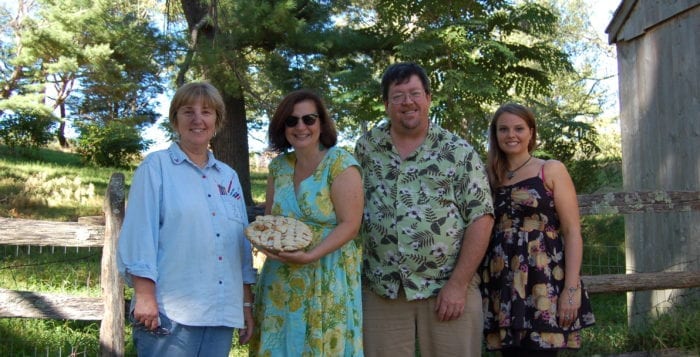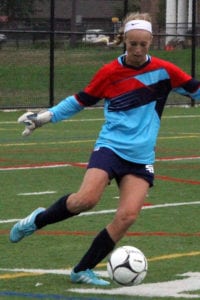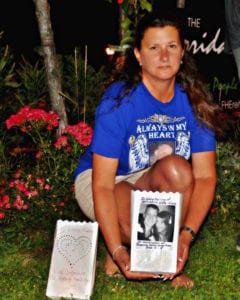Sitting Pretty
Jay Gammill of East Setauket took this gorgeous photo of a female black swallowtail butterfly taking a sip of nectar from tall garden phlox in his backyard in August.
Send your Photo of the Week to [email protected].
Sitting Pretty
Jay Gammill of East Setauket took this gorgeous photo of a female black swallowtail butterfly taking a sip of nectar from tall garden phlox in his backyard in August.
Send your Photo of the Week to [email protected].

The humble apple will be the focus of the largest Apple Pie Baking Contest on Long Island, to be held in conjunction with the 27th Annual Long Island Apple Festival Sunday, Sept. 25, at the Sherwood-Jayne Farm, 55 Old Post Road, Setauket, from 11 to 4:30 p.m. Participants get a chance to show off their favorite family recipes and participate in an old-fashioned blue ribbon competition. The contest is sponsored by Homestead Arts, the Society for the Preservation of Long Island Antiquities and the Greater Port Jefferson-Northern Brookhaven Arts Council.
 Entries must be traditional apple pies only. Pie, including crust, must be homemade by amateur bakers. Early registration is preferred, before Thursday, Sept. 22, but registrations will also be accepted on the day of the festival. Pies must be on the contest table at the Sherwood-Jayne House before 11 a.m. on the day of the festival. A written recipe must be submitted with each entry including the name and address of the baker. Each contestant will receive one free Apple Festival entry.
Entries must be traditional apple pies only. Pie, including crust, must be homemade by amateur bakers. Early registration is preferred, before Thursday, Sept. 22, but registrations will also be accepted on the day of the festival. Pies must be on the contest table at the Sherwood-Jayne House before 11 a.m. on the day of the festival. A written recipe must be submitted with each entry including the name and address of the baker. Each contestant will receive one free Apple Festival entry.
The judging will begin at 2 p.m. with prizes awarded between 3 and 4 p.m. First-, second- and third-place winners will be announced for Best Tasting Pie, and there will be a prize for Best Looking Pie. Several local judges will participate along with an Everyman judge chosen from our Apple Festival audience. All winners will receive a prize. Past prizes have included a brunch or dinner for two at fine restaurants, theater tickets, gift baskets and gift certificates, to name a few. The first-place winner will be invited to be a judge at next year’s Apple Pie Baking Contest. All pies, including their dishes, will be auctioned off after the winners are announced.
For contest entry forms, visit www.splia.org. For more information call 631-692-4664.
Stony Brook residents visited the Brookhaven Town Board meeting last week to register their dismay over the large scale tree removal planned for the Strathmore housing development.
A total of 11 people addressed the issue of tree removal prior to road resurfacing during the public participation portion of the meeting.
The Brookhaven Highway Department has marked trees on several M-section streets.
Several of the speakers at the meeting were residents of the M-section, but others weighing in on the topic were just concerned citizens.
As commenters took to the microphone to express their frustration with the situation, Supervisor Edward Romaine (R) interjected and said he wanted to make it clear that these actions are not the responsibility of the town board.
“I just want to point out one thing,” he said. “The actions with the trees are not the actions of this board. They are the actions of the highway superintendent, who is an independent elected official.”
Community activist MaryAnn Johnston, of Mastic, commented on the highway superintendent’s aggressive paving policy. She said he paid no mind to resident objections in Coram regarding tree removal. “He needs to give communities advance notice — and he needs to follow the state-mandated SEQR (State Environmental Quality Review Act) process,” she said.
“People would rather live with those potholed streets than lose the trees.”
—Robert de Zafra
According to the state’s Department of Environmental Conservation website, the act “requires all state and local government agencies to consider environmental impacts equally with social and economic factors during discretionary decision-making.”
If there is potential for significant adverse environmental impacts, the site further explains, an environmental impact statement is required.
According to the Highway Superintendent’s office, SEQR does not apply in this situation. Based on Section 617.5 (c4), the project is part of an “in place, in kind” replacement of structures. A spokesperson for the office said this is only a repaving planned for an existing road, and no expansion is being made.
Prior to the start of public participation, Deputy Highway Superintendent Steve Tricarico was invited to make a statement. He acknowledged the presence of the M-section residents and said he was there to listen to them.
“I speak on behalf of the superintendent of highways when I state that it is by no means our intention to purposely remove trees or replace concrete that is not necessary,” he said. “In order to resurface these roadways, to mill them and to pave them, certain aspects of the root systems as well as the concrete are causing serious concerns to the department.”
After the outcry from the neighborhood, Tricarico said a letter was sent to affected M-section homeowners, stating that a re-evaluation would be made to determine which trees are absolutely necessary to remove.
Town Councilwoman Valerie Cartright (D-Port Jefferson Station) asked Tricarico if the superintendent is willing to participate in a community meeting once the reassessment is completed. Tricarico said Losquadro has already met with some of the concerned residents.
“I know the superintendent has been up there personally and has met with a number of residents … has spoken with them, both on and off camera, and will continue to do so moving forward,” Tricarico said.
Cartright said she will schedule a meeting and notify the community so they can be present to hear the department’s findings. The date of that meeting is not yet known.
Three Village Civic Association President Robert de Zafra, who was present to support historical status for a Stony Brook building, said he decided to add his voice to save the trees.
“People would rather live with those potholed streets than lose the trees,” he said. He also thanked Cartright for working to set up the future meeting.
Free prostate screenings will be offered on Saturday, Sept. 10, from 9 a.m. to 3 p.m. at John T. Mather Memorial Hospital.
The screening, which will take place in the Fortunato Breast Health Center, will include a prostate-specific antigen (PSA) screening and a digital rectal exam. No fasting is required.
A limited number of screenings are available. Registration is required. To make an appointment, call Mather’s Public Affairs Department, Monday-Friday, between 9 a.m. and 5 p.m., at (631) 476-2723.
Prostate cancer screenings are recommended for men age 50 and older who have not had a screening in the past 12 months.
John T. Mather Memorial Hospital is located at 75 North Country Road in Port Jefferson.

By Rita J. Egan
The sounds of bluegrass, blues and folk music will fill the air at Benner’s Farm once again when the homestead hosts the fifth annual Fiddle & Folk Festival on Sept. 11. Presented by Homestead Arts, Benner’s Farm, the Greater Port Jefferson-Northern Brookhaven Arts Council and WUSB Radio, the festival will be held from 11 a.m. to 7 p.m., rain or shine.
“It’s kind of a laid back, easy going, good sounding old-time festival,” Bob Benner, owner of the farm, said. The Benners began hosting the festival a few years ago after the owner and the late Gerry Riemer, a board member of Homestead Arts, were discussing the possibility of a September event on the property. The two remembered how much fun the Fiddle & Folk Fest, formerly held on the property of the Long Island Museum, was and began to ask people what they thought of the event being held at Benner’s. They received positive feedback, and Benner said that the first two years the Long Island Traditional Music Association (LITMA) worked with them on the event.
The combination of music and a farm setting has turned out to be a successful one, and Benner estimates the number of attendees last year to be around 500. “It’s completely different than any other concert I’ve ever been to, because it’s a farm and people can wander around,” the owner said.
Benner said attendees are welcome to explore the organic, solar-powered working farm while listening to the music, and with people so connected to their cell phones and other gadgets nowadays, he enjoys seeing people interacting with each other and connecting with nature. “Every time that people come here it is just so enjoyable to see them wandering around, looking at animals, looking at the garden,” he said. The farm owner enjoys the music at the festival, too. “I’m not a musician’s musician, so I enjoy very much listening to some of the groups that come that I don’t normally hear,” he said.
Amy Tuttle, program director of the Greater Port Jefferson-North Brookhaven Arts Council, said one of the things she loves about the festival is seeing family members and friends coming together and enjoying the music. “It’s easy to enjoy the festival. It’s not overcrowded, and it’s a chance to see not only some very talented local performers but internationally known performers in a very relaxed setting,” she said.
Sponsored by The Bridgeport & Port Jefferson Steamboat Company and emceed by Bob Westcott, the festival will feature headliners Steve Forbert, the Feinberg Brothers Band, the Claudia Jacobs Band and Jeff Davis and Maria Fairchild playing on the Backporch Stage. Tuttle said Forbert is internationally known for his hits in the late ’70s and early ’80s. The singer of “Romeo’s Tune” recently released the album “Compromised,” which the program director said sounds terrific. “We’re reaching out to a bigger music community by bringing Steve Forbert in,” she said.
Reaching out to a bigger music community helps with the main goal of the festival. “The mission is to connect the artists with an audience that appreciates what they do — it’s pretty similar to what the arts council’s mission is and what WUSB’s mission is,” Tuttle said. According to the program director, Jeff Davis is also well known in the world of traditional folk music. On Sept. 11, he will be playing fiddle, and Maria Fairchild will be joining the musician on banjo. Tuttle says the duo has a big following of fans of old-time music. “I love it all. Most people who come to this festival like the folk songwriter music, but all the performers are very good in their own style,” Tuttle said.
The festival also offers a Contra Dance with a live band led by Rusty Ford as well as a Kids Corner where children can enjoy stories and music.
Benner said the featured artists will meet and hold workshops at the Shady Grove Stage close to the woods, and Charlie Backfish of WUSB radio will be on hand to host the activities. Attendees can participate in the Fiddle Workshop at Jam Hollow, too, and bring their own instruments to join in on the musical fun.
“It gives people a chance to either sit back and be entertained or participate wherever they feel comfortable,” added Tuttle.
Benners Farm is located at 56 Gnarled Hollow Road in East Setauket. Admission to the festival is $18 for adults and $13 for children and seniors. Bring seating. For more information, please call 631-689-8172 or visit www.fiddleandfolk.com.

The Ward Melville girls’ soccer team faced some adversity late in the first half of their season-opening game, but the Patriots pushed through the wind, kept their heads up and got down to business.
Junior striker Kerri Liucci scored a hat trick to propel Ward Melville’s 4-1 win over Smithtown West in nonleague action Sept. 5.
“It’s the first time we’ve scored a hat trick in a while,” Ward Melville head coach John Diehl said. “We got a bit rattled, but I spoke to them at halftime about keeping their composure, getting their minds in the right place and winning the 50/50 balls in the middle and establishing our game we had in the first 20 minutes, and I think we did that.”

Less than three minutes into the game, Liucci scored her first goal after some back and forth in front of the net off a corner kick allowed her to knock the ball into an open right side of the net.
“I was trying to find the ball; trying to get a hit off of it,” she said. “Smithtown West went to go clear it, but I got my body in front of it.”
She tallied her second goal minutes later, when Smithtown West’s goalkeeper Gabby Lorefice came out of the box to stop the ball.
“I kept my composure, and let myself play how I usually do,” she said.
With three minutes left in the first half, Smithtown West senior forward Alicia Daoust scored off a corner kick, and the Bulls’ bench erupted in excitement, which gave them a boost heading into halftime.
Both teams came out ready to fight in the second half, and Lorefice made some of her crucial nine saves on the evening in the final 40 minutes to keep her team in the game.
“We came out a bit flat and it cost us in the beginning — they made us pay for it,” Smithtown West head coach Rob Schretzmayer said. “They pressed us. They’re a good team, and just very aggressive. We were on our heels, and we were chasing a little at the end. Credit to [Ward Melville] — with the wind on their back—they caught us again.”
With 17:49 left to play, a high kick bounced over Lorefice’s head, and Liucci scored her third goal of the game. Junior back Victoria Vitale added insurance with just under 10 minutes left.

The Patriots, are loaded with experienced upperclassmen on their roster, an advantage not lost on one of the team’s leaders.
“Our fitness is really high, we work really well together and have a really good relationship with each other that I think translates onto the field,” senior center back Megan Raftery said. “I’ve been playing with some of these girls since kindergarten, so we know each other’s strengths and we know how to build on each other’s strengths.”
That chemistry showed in connected passes and the girls getting open for one another, according to Liucci, who said the team is looking to make a big statement this season.
“We’ll keep working hard in practice and pushing one another,” she said.
Despite the 4-1 victory, Diehl still saw room for his team to improve.
“With the experience we have and the attitude of the girls, this is a special group,” he said. “This group wants to play and want to do the best. They’re getting over that mental hump and gaining confidence, and I think they’re looking good. Given the quality of the opponent — Smithtown West one of the top teams in the county — gives us a better understanding of what level we can play at, and gives them the confidence to believe in themselves. We can play really good soccer.”
Suffolk County Legislator Kara Hahn (D-Setauket) and New York Gov. Andrew Cuomo (D) are teaming up to help North Shore residents prepare for a natural or man-made disaster. The lawmakers will host a free NYS Citizen Preparedness Training event Sept. 10 from 10 a.m. to 11:30 a.m. at Port Jefferson Village Center, located at 101 East Broadway.
Participants will learn how to develop family emergency plans, how to stock up useful supplies and will receive a free disaster preparedness kit containing vital items if a disaster were to strike.
“The state training and kits will help New Yorkers be the most trained and best-prepared citizens in the country,” a release from Hahn’s office said.
Those interested in participating should visit www.prepare.ny.gov to register in advance of the event.

Rebecca Anzel
When Daniel Scofield died in 2011 from a heroin overdose, his mother Dori decided to do something.
“I wasn’t going to keep [his death] under the carpet,” she said. “I just said, ‘I’ve got to bring this out into the world. My son was my life and I’m not going to bury his addiction with him. I have to help others. I have to bring awareness.’”
In April 2014, the founder of Save-A-Pet Animal Rescue and Adoption Center started Dan’s Foundation for Recovery, a not-for-profit organization that provides assistance to those suffering from alcohol or substance abuse. The group uses its donations to help an addict get help — it assists addicts in covering insurance copayments, treatment and travel costs to recovery centers in other states.
Scofield co-hosted Lights of Hope on Aug. 31 at Memorial Park in Port Jefferson. The event, which is in its third year, brought together families and friends to remember those who died from a drug overdose and to support those who are recovering from drug addiction.

The event’s other co-host was Public Relations Director Debbie Gross Longo of the New York Chapter of Magnolia New Beginnings, an advocacy, education, support and addiction resource group.
“Each year, unfortunately the crowd gets bigger,” Longo said. “We lose about 129 kids a day throughout the United States. This is something that is an epidemic. It has gotten out of control and there’s no reason for it.”
Longo’s son was a soccer player at Ward Melville High School. He was so talented, she said, he was being scouted by colleges. That was before he tore his quadricep.
The doctors at John T. Mather Memorial Hospital in Port Jefferson prescribed him oxycodone, and he became addicted. The price per pill of oxycodone is expensive — about $45 each, Longo said. So he switched to heroin, a much less expensive but more potent drug. Before long, his personality began to change.
“The changes happened pretty quickly until I couldn’t ignore it any longer, and that’s when he went to rehab,” she said. “It didn’t work the first time, it didn’t work the second time and it didn’t work the third time.”
Longo said her son is now living in a sober community in Florida helping other addicts get into recovery.
According to a 2015 New York State Opioid Poisoning, Overdose and Prevention report, there were 337 heroin-related deaths in Suffolk County between 2009 and 2013 — more than any other county in the state during that period.
“We come together to celebrate the lives they lived, we’re celebrating the recovery and we’re celebrating the people who are still struggling. We will never give up hope. Where there is life, there is hope.”
—Tracey Budd
In a brief speech at the Lights for Hope event, Scofield stressed the importance of helping those addicted to the drug get into recovery. Earlier that day, she said, she helped a young girl who lost her mother get into the Long Island Center for Recovery in Hampton Bays as well as three other young people get into a rehabilitation facility in Arizona.
In starting Dan’s Foundation, Scofield “wanted mostly to help kids that sought treatment now — not 10 days from now,” she said. “In 20 minutes, they’re gone. You have a small window of opportunity to help them and you’ve got to do it when you can do it.”
Scofield’s son David, 28, went through heroin recovery. His mom said her sons were best friends and they did everything together, including using heroin.
“I struggled with this disease for a long time,” he said to those who attended the Lights for Hope event. “I found a way to live sober. I found a different way to live my life.”
Event attendees decorated white paper bags with the name of a loved one who died from heroin or who recovered from it, and a message. Toward the end of the evening, a candle was placed inside each bag, and they were arranged in a large circle around the cannon in the park.
“We come together to celebrate the lives they lived, we’re celebrating the recovery and we’re celebrating the people who are still struggling,” Tracey Budd, a Rocky Point resident and founder of North Shore Drug Awareness Advocates, said. “We will never give up hope. Where there is life, there is hope.”
Budd’s son Kevin died in September 2012 from a heroin overdose. Her daughter Breanna has been drug-free since May 2014.
She said the stigma of addiction has changed dramatically since 2008 at the height of her son’s struggle with heroin. There is now a community of families that support each other through a child’s struggle with addiction or an addict’s death.

“It’s sad to say, but when you feel the hug of another mother who’s lost a child, even if you’ve never met, no words need to be spoken,” Budd said. “It’s a connection that we wish we didn’t have, but we do, and it’s actually pretty amazing.”
Middle Island resident Hugh Rhodus said the worst part of the heroin problem on Long Island is going to a funeral for a young person. He recently attended the funeral of a friend’s 24-year-old nephew.
“Going to a kid’s funeral is the hardest thing, but unfortunately we do it all the time,” he said. “It’s so hard to do. Kids that age laying in a casket is awful.”
Rhodus and his wife helped their daughter Amanda through her 13-year struggle with heroin. He said when they first tried to get her help, they took her to Mather Hospital, where they waited for a couple of hours after speaking with a nurse in a “room in the back.” Eventually, they were told to go to a hospital in Nassau County because Mather Hospital was unable to help Amanda.
“It’s your daughter, she’s sick, she’s a drug addict and that’s how we found out how powerful the stigma was,” Rhodus said. “We fought for years to get her in and out of treatment — it was tough. It was really tough.”
Legislator Sarah Anker (D-Mount Sinai) praised families and recovering addicts for not giving up.
“We can’t give up,” she said. “Everybody has to be engaged and participate because it is our lives and our children’s lives and our loved ones lives that’s on the line.”
No catch and release here:
Karen Silvestri of Melville recently captured this image of a juvenile black-crowned night heron fishing for its next meal at Avalon Park and Preserve in Stony Brook.
Send your Photo of the Week to [email protected].
Bluegrass fans rejoice! The Long Island Museum, 1200 Route 25A, Stony Brook in conjunction with the Bluegrass Club of Long Island will welcome Eastbound Freight with the Jeff Davis Maria Fairchild Duo for an evening of live bluegrass in the Carriage Museum’s Gillespie Room on Friday, Sept. 9 at 6:30 p.m.
The band members share a life-long connection to the music and a love for the big bluegrass sound of the original groups: Bill Monroe and the Bluegras Boys, Flatt & Scruggs, The Stanley Brothers, Jimmy Martin & the Sunny Mountain Boys and others. Their repertoire includes tunes popularized by these groups as well as many original songs by banjo player Bill DeTurk.
Advance tickets may be purchased at www.longislandbluegrass.org for $14. If available, full-priced tickets may be purchased at the door (cash only) for $20. For questions, please contact [email protected].
